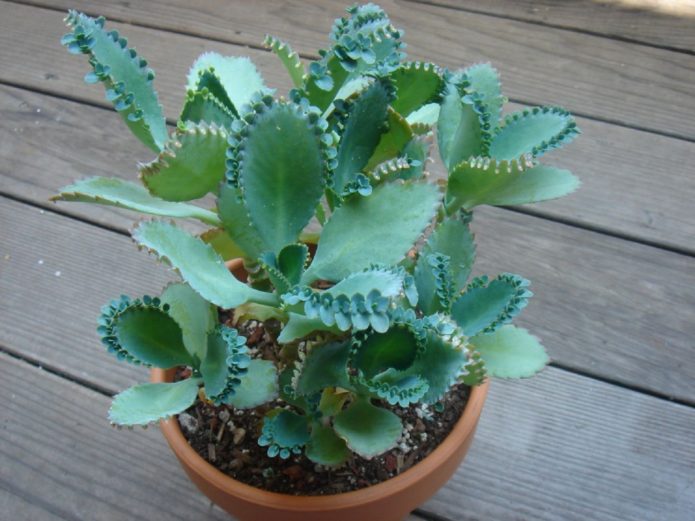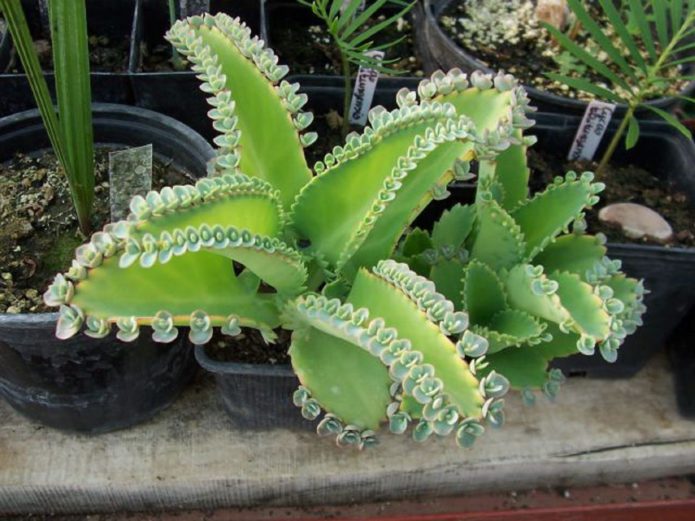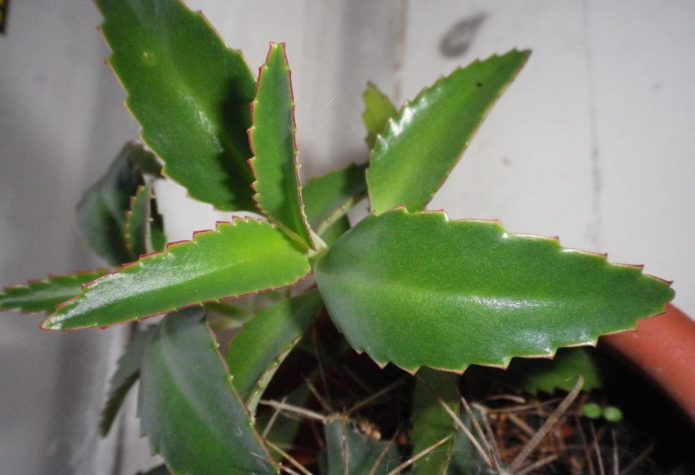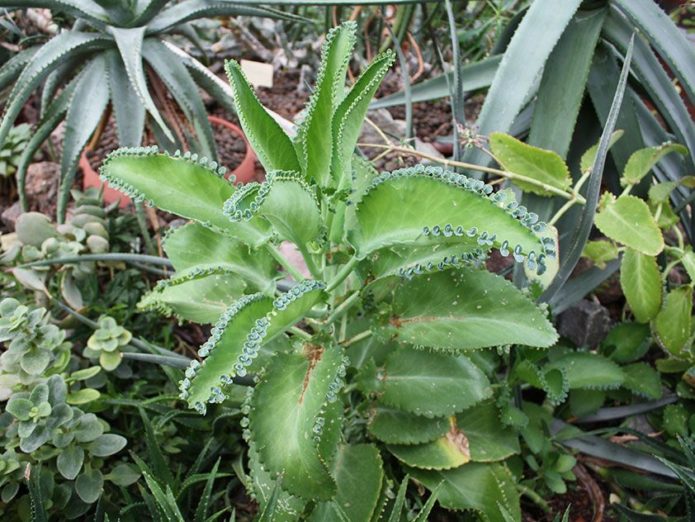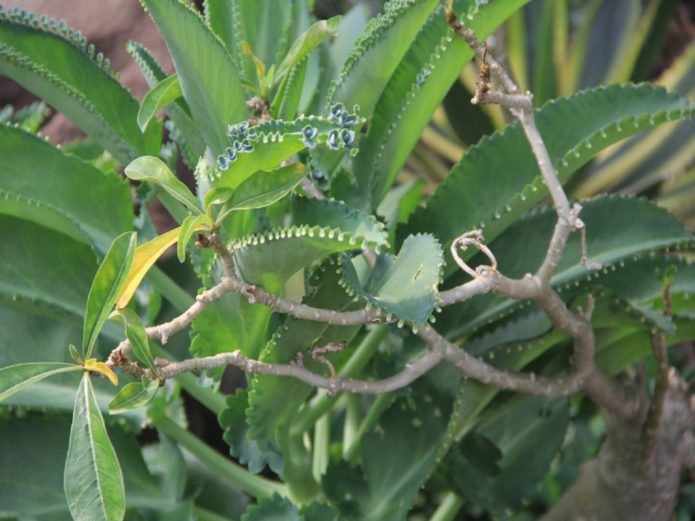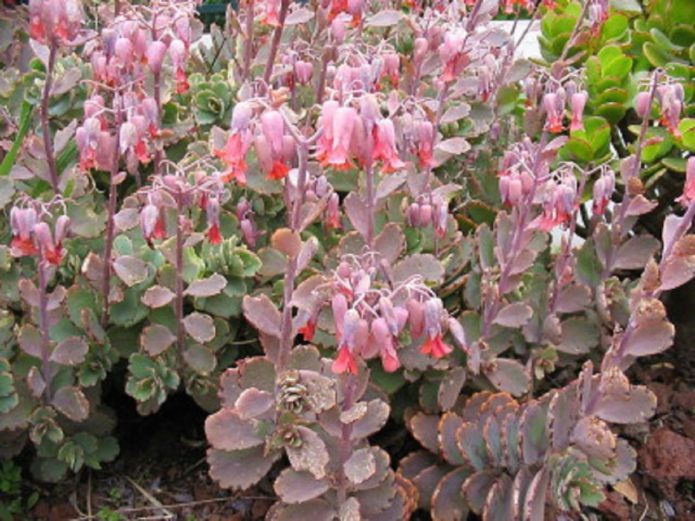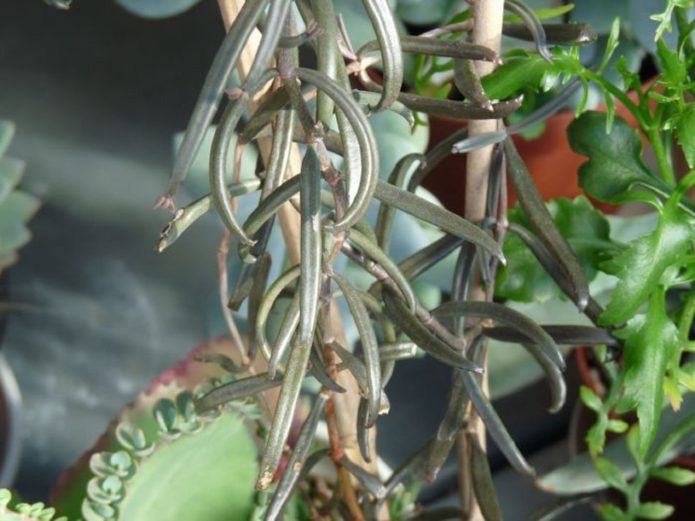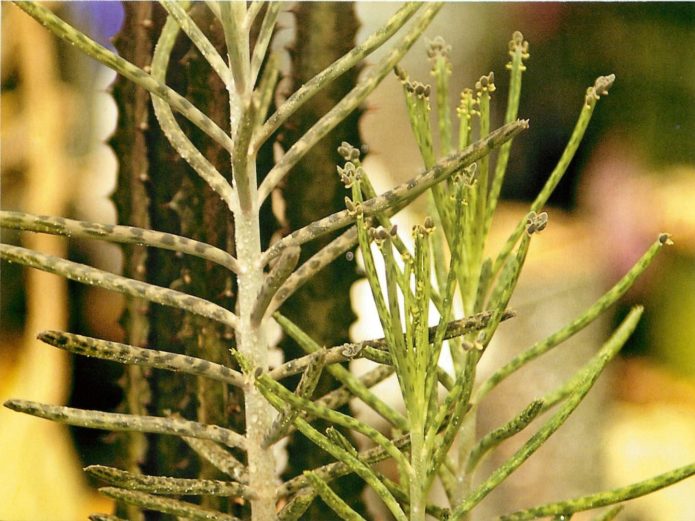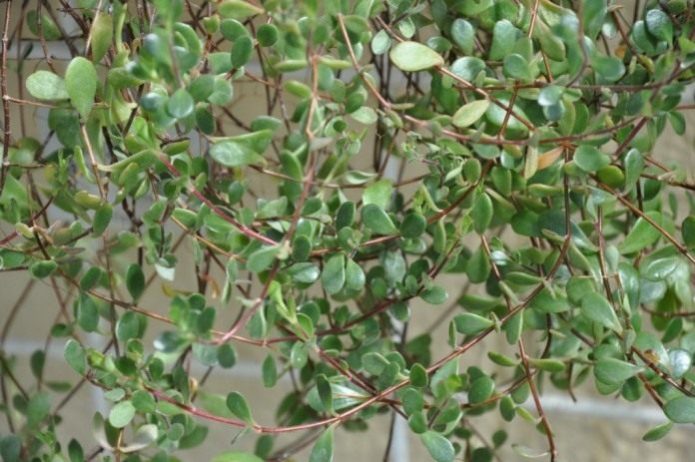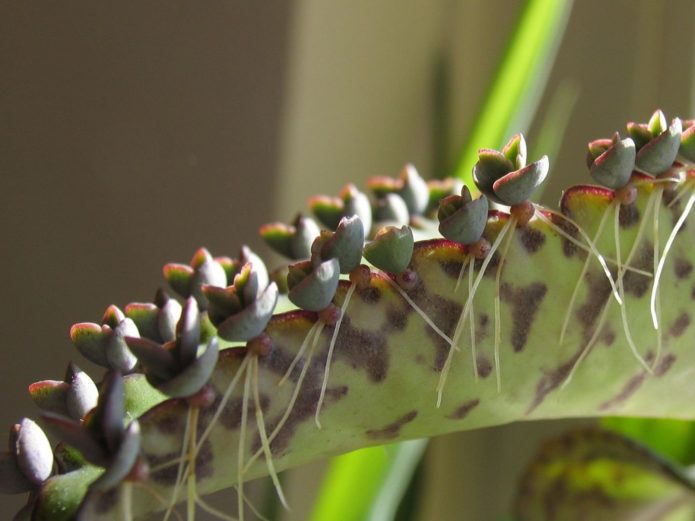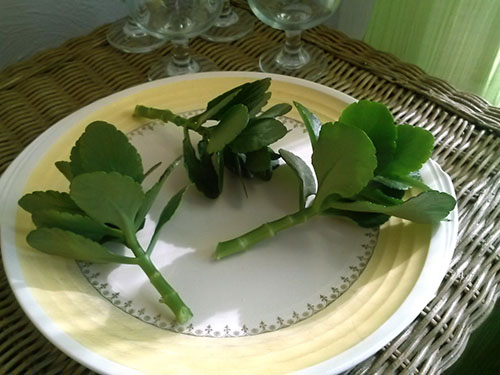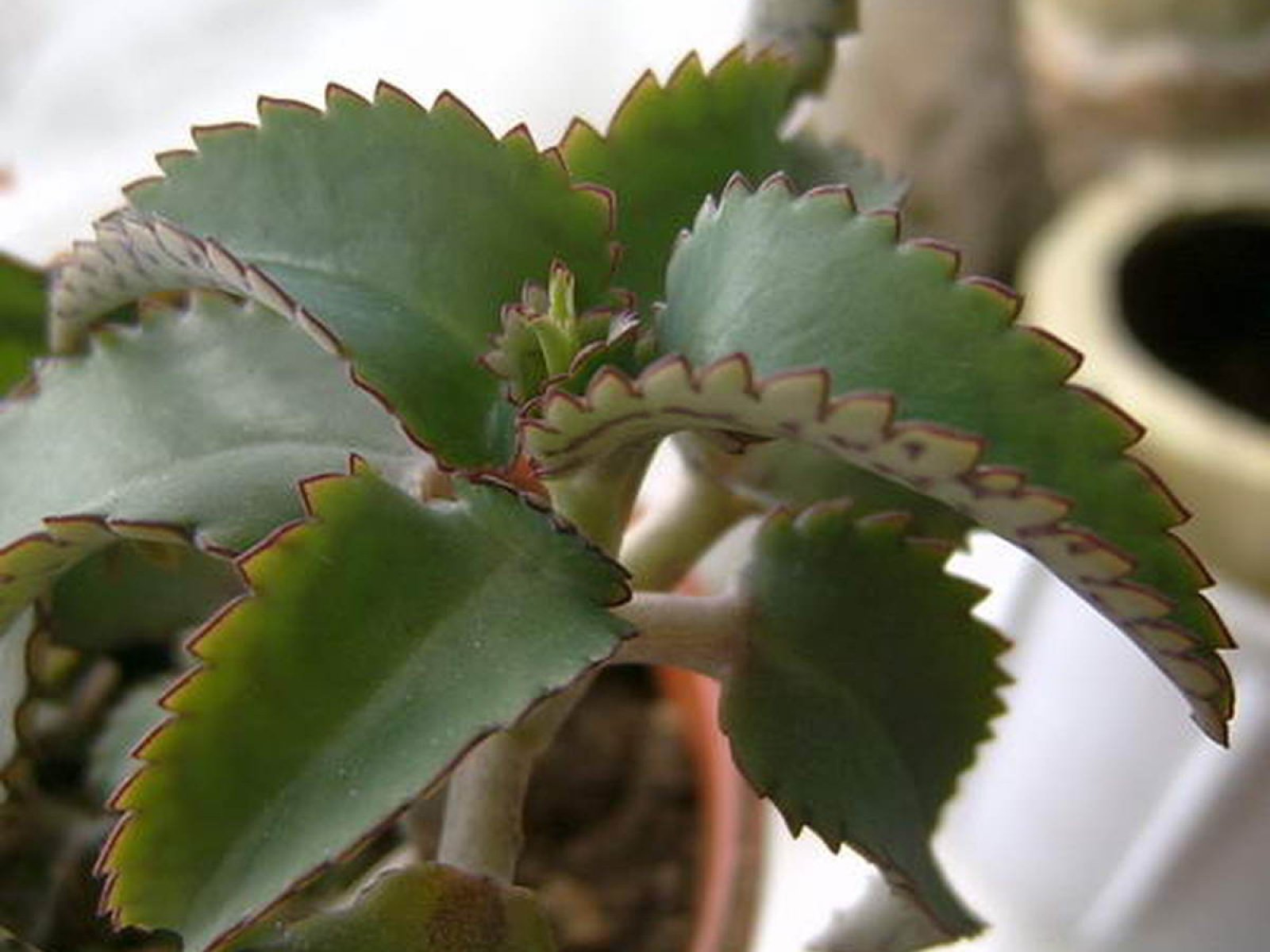Bryophyllum is a succulent perennial plant from the Tolstyankov family. This is a native of South America and the islands of Madagascar. The genus is quite diverse, it includes flowering, decorative deciduous and medicinal species. Bryophyllum is often confused with Kalanchoe, due to the similarity in appearance and medicinal properties. Due to its unpretentious care and resistance to conditions of maintenance, the plant is especially popular in home floriculture.
Content
What is this indoor flower and who will it come in handy
Bryophyllum is so unassuming that it can take root anywhere. For the summer period, the plant is suitable for keeping it outdoors - in the garden or on the balcony. Creeping and climbing species that grow as ampelous crops need more care and attention.
Description of bryophyllums and differences from Kalanchoe, photo
Bryophyllums are combined into a group of succulents belonging to the category of viviparous plant representatives... Growing in nature, they form shrubs and semi-shrubs that can grow up to 2 meters in height. Among the existing species of bryophyllum, there are different specimens by the nature of growth:
- upright;
- branching;
- creeping;
- curly.
Depending on the species, the plants have differences in the shape and color of the leaves. By tone, they can be:
- green;
- brown;
- gray-gray;
- brown.
According to the configuration, the leaves are oval, feathery, lanceolate, with and without notches along the edges. The uniqueness of the plant is that daughter neoplasms (babies) with separate roots and leaves are formed along the edge of the leaves. At the slightest touch of the plant, they crumble and soon take root in the ground, giving rich growth. By this physiological feature, one can distinguish bryophyllum from Kalanchoe.
And this is what the Kalanchoe looks like.
Bryophyllums are short-day plants, so they bloom mainly in winter and early spring. A month later, the buds wither and in their place multi-seeded fruits appear.
Some types of bryophyllum are toxic, so care should be taken when handling them. They should not be located where there is direct access to plants for children and pets.
Signs and superstitions associated with the plant
According to popular beliefs, bryophyllum contributes to the creation of peace and harmony in the house, replenishes energy losses in the people around it and absorbs negativity. This prevents the development of depression and helps to endure any troubles in life. If the plant dies unexpectedly, then it protected the home from misfortune. Purchase a new one immediately. It is recommended to place the flower in the kitchen or living room, where all household members usually gather. Bryophyllum blooms actively only in a favorable atmosphere.
In India, locals use bryophyllum to drive out evil spirits and attract good ones. And also their plant is in demand in medical practice to combat cholera and smallpox.
Bryophyllum varieties for home breeding (with photo)
The genus Cactus, which includes bryophyllums, includes more than 20 species of plants found mainly in Madagascar and growing on rocky ground. Only a few varieties are cultivated at home.
Bryophyllum Degremona
The plant, better known by its old name, is the Kalanchoe Degremona. People call it “Goethe's flower” or “indoor ginseng”. It is a compact dense bush with glossy broad-lanceolate leaves with serrated edges. The rich green color of the leaf plate on top contrasts with the brown strokes on the back. Children along the edge of the sheets create a kind of openwork border. The flowers of this representative are large, similar to bells, only of a pinkish-purple hue and are collected like brooms.
Bryophyllum pinnate, or calyx
A specimen with upright branching shoots forming a dense rosette. The leaves are fleshy, light green and differ in shape depending on the location: from below - oval, from above - lanceolate or complex-pinnate. They are bordered with red teeth. Children are on the plant all year round. Even if they are not there, it is worth picking and placing the leaf in water so that they appear soon. This bryophyllum blooms with rich scarlet buds.
Cirrus bryophyllum has the same medicinal properties as Degremona, only recognized by official medicine. The extract from the plant is used in dentistry, gynecology and other fields.
Bryophyllum Fedchenko
A species that is inferior in medicinal properties to analogues from the genus and belongs more to decorative representatives. This is due to the external beauty during the flowering of the plant. The rest of the time, the flower also looks attractive - this is expressed by matte bluish leaves, framed by an openwork ruffle from many children. A distinctive feature of this species is a red stripe running along the edge of the leaf plates. It blooms no less spectacular - with bright orange-yellow or pink inflorescences on the tops of the leaves. After flowering, buds come to life, from which young shoots appear.
Bryophyllum Bouvard
This species is also known as Bryophyllum Boveri. Quite a rare ampel-type succulent and almost the only specimen that successfully took root in indoor conditions. The plant lets out brittle thin shoots up to 60 cm long, but in the natural environment they can stretch for several meters. The leaves are dark green with a brown tint, strongly narrowed and elongated. Outwardly, they resemble tubes with curved, serrated tips, like claws. The resinous purple spotted flowers give the plant even more mystery. Such a vine looks original in the interior..
Bryophyllum tube-flowered
This variety is distinguished by whorled narrow leaves with small specks along the edge. Children are formed only on the upper part of the leaf plate and in small quantities. Therefore, the succulent looks unusual because of its nudity. But tubular bryophyllum blooms beautifully with large bell buds of red-pink or yellowish-orange colors, grouped in umbrella inflorescences at the ends of half-meter shoots.
Bryophyllum Mangina
This exotic species is rapidly gaining popularity among flower growers. Its advantage is its colorful and non-standard flowering in the form of small drooping bells of various colors (pink, orange, red) with emerald bracts. In the course of growth, the plant forms neat bushes of small oval green leaves.
Unlike other species of the genus, varieties bred on the basis of Mangin bryophyllum are capable of blooming regardless of the season at standard room temperature.
The healing properties of the indoor flower
In official pharmaceuticals, only pinnate bryophyllum is recognized, accordingly, only its chemical composition was investigated. The plant is considered a storehouse of biologically active components.
Many other medicinal types are used at their own peril and risk.
For medicinal purposes, the juice from the leaves is mainly used, which has many properties:
- anti-inflammatory;
- pain relievers;
- wound healing;
- antiseptic;
- antimicrobial.
Against this background, when applied externally, juice helps in the following cases:
- burns, hard-to-heal wounds, trophic ulcers, bedsores and other damage to the skin;
- phlebeurysm;
- stomatitis, periodontal disease;
- tonsillitis, sinusitis, tonsillitis;
- eye pathologies.
Bryophyllum juice and leaves are effective pain relievers. Here's one homemade recipe to help relieve muscle pain and any other pain:
- Pick a few leaves and put them in the refrigerator for 6-7 days.
- Pass them through a meat grinder and squeeze the juice with gauze.
- The obtained juice is preserved by adding pure alcohol (10 ml per 1 liter). Keep the mixture cool.
In this juice the tissue is moistened, squeezed well and applied to painful areas for 20 minutes 3-4 times a day.
In addition to basic medicinal properties, bryophyllum is able to absorb harmful microbes from the air, thereby improving the indoor microclimate.
Features of home care
All bryophyllums thrive at home and need minimal maintenance. Only this does not mean that the plant should be treated negligently. Subject to the basic rules, the flower will delight the owners with beautiful flowering for more than one year.
Table: Recommended seasonal microclimate for keeping bryophyllum
| Season | Temperature | Humidity | Lighting |
| Spring Summer | Ideal + 25-28 ᵒС, permissible - from 18 to 30 С | Does not affect the condition of the plant | Dispersed with protection from the midday heat. It is preferable to place flower pots on southern, eastern or western windowsills. In partial shade, bryophyllum blooms worse |
| Autumn winter | 14-17 ᵒС |
Watering
Bryophyllum, in terms of substrate moisture requirements, is not much different from other indoor succulents. Since the plant can accumulate moisture in the leaves, then watering should be scanty even on hot days. It is important that no water accumulates at the roots. The presence of drops on the leaves is also undesirable, which leads to the development of putrefactive processes. Therefore, root watering is a priority. In spring and summer, bryophyllum is moistened as the upper soil layer dries, in winter - once every 2 weeks.
This representative tolerates drought without any problems. Moreover, keeping it dry is beneficial for development. Therefore, in case of accidental overflow, it is necessary to let the soil dry out completely and only then return to the usual mode.
Top dressing
Bryophyllum needs feeding only during the spring-summer period, when they are applied a maximum of 2 times a week. It is recommended to use ready-made fertilizing mixtures for cacti and succulents. The dosage indicated in the instructions is reduced by 2 times. If you want to achieve lush flowering, they continue to feed the plant in the autumn and winter seasons, only once a month. During flowering, you can replace standard fertilizers with compositions for decorative indoor plants, and then return to the old ones.
Pruning
By pruning and shaping the bushes, we mean the removal of dried, yellowed and damaged leaves. Along with this, flower stalks are cut off after flowering and excess shoots, which create excessive thickening. Thus, the bushes are given the appropriate shape. When bryophyllum loses its visual appeal, then it is worth replacing it with a fresh specimen. In a situation like this, no amount of cropping will help.
Transfer
Bryophyllum is not particularly affected by transplantation, so the procedure does not require following the rules of caution. Even if the roots are damaged, the flower quickly takes root in a new place. Young plants are transplanted annually, adults - as the root system grows. Any loose and light mixture intended for succulents is taken as a soil. You can cook it yourself in the following ratio of ingredients:
- sod land - 20%;
- leaf compost - 20%;
- garden soil - 40%;
- sand - 20%.
The containers are selected small in volume, since the roots of the bryophyllum are compact. A drainage layer (about 5–6 cm) of brick chips or expanded clay is poured into the bottom of the new pot.
Care during periods of rest and flowering
To prolong the flowering time of bryophyllum, it is recommended to keep it in a place with good light. Additionally, this will prevent the shoots from stretching and thinning. Universal feed for succulent plants is applied 2 times a month in the amount indicated on the package.
After flowering, the buds are plucked, the flower is rearranged in the shade and the amount of watering is reduced to a minimum. This will allow the plant to gain strength for a full dissolution in the future.
Video: how to grow succulents at home
Table: growing problems and solutions
When growing homemade ginseng, growers, especially beginners, sometimes face a number of problems. This is usually due to improper care.
| Problem | Cause | Correction method |
| Excessive stretching of shoots and dropping of the lower leaves | Lack of sunlight, coupled with a high temperature in the room, especially when the flower is near the battery | The plant is placed next to a window facing west or east in summer, and south in winter. Move the pot to a cool place |
| After the completion of flowering, the plant is inhibited in growth | Nutrient deficiency | Bryophyllum is transplanted or fed |
| Does not bloom | Excess fertilizer | Reduce the number of dressings |
| Black or brown spots appear on the leaf blades | High humidity in the room at low temperatures | They transfer the plant to where the optimal conditions are |
Diseases and parasites
Bryophyllum does not tolerate stagnation of moisture, which ultimately leads to the development of diseases of fungal origin:
- fusarium;
- black rot;
- anthracnose;
- rust;
- powdery mildew.
At the first signs of damage to leaves and shoots (white bloom, dark spots), it is necessary to cut off the diseased areas, sprinkle the cuts with charcoal and perform a fungicidal treatment of the entire bush. If the disease progresses, then it is necessary to root the remaining healthy parts of the stem.
Of the pests, the following are especially dangerous:
- aphid;
- shield;
- mealybug;
- spider mite.
The plant is washed with soapy water and sprayed with any insecticidal preparation (Aktellik, Fitoverm, Confidor) prepared according to the instructions. The procedure is carried out 2 times with an interval of 10 days.
Reproduction methods
Bryophyllums can reproduce in three ways:
- children;
- cuttings;
- seeds.
Children
The first option does not require the application of special forces. It is enough for the leaf buds to come into contact with the ground, as soon they will germinate, since their roots are formed even when they are on the leaf.
Cuttings
This option is possible in the following design:
- A shoot up to 10 cm long is cut from above and immersed in water.
- They wait until new roots appear.
- Fertile soil is prepared and a sprouted cutting is planted.
Rooting is fast. And the next year the plant blooms.
Seeds
Many growers prefer to propagate bryophyllum by seed. Their germination is high and the process itself does not take much time. Sowing is carried out in early spring, which will require a loose and light substrate. The optimum temperature for germination is 20–22 ᵒС.
Adhere to the following instructions:
- The seeds are spread evenly over the surface of the moistened ground and pressed slightly by hand.
- Stretch a plastic wrap over crops or cover with glass to create a greenhouse effect inside.
- Every day, the protection is opened slightly to ventilate and remove accumulated condensation.
- The shelter is completely removed as soon as the first shoots hatch.
- With the formation of 2-3 strong leaves, a dive is made, during which weakened seedlings are removed. Strong sprouts are planted in separate containers.
The first flowering can already be expected by winter.
Bryophyllum is loved by many people, even those far from floral themes. This plant attracts not only by its appearance, but also by its beneficial properties. Such decoration on the windowsill can replace a home first aid kit. Moreover, the succulent does not need special care. It is enough to place it in the right place, periodically water and feed it.
